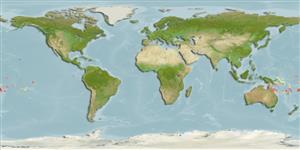Classification / Names
Common names | Synonyms | Catalog of Fishes (gen., sp.) | ITIS | CoL | WoRMS | Cloffa
Actinopterygii (ray-finned fishes) >
Perciformes (Perch-likes) >
Pinguipedidae (Sandperches)
Etymology: Parapercis: Greek, para = the side of + Greek, perke = perch (Ref. 45335); xanthogramma: Named for the yellow bands on the cheek region of the males.
Environment / Climate / Range
Ecology
Marine; benthopelagic; depth range 0 - 6 m (Ref. 75058). Tropical, preferred ?
Distribution
Countries | FAO areas | Ecosystems | Occurrences | Point map | Introductions | Faunafri
Central Pacific: Fiji, Tonga and Western Samoa.
Size / Weight / Age
Maturity: Lm ? range ? - ? cm
Max length : 17.4 cm SL male/unsexed; (Ref. 75058); 15.8 cm SL (female)
Short description
Morphology | Morphometrics
Dorsal
spines
(total): 5;
Dorsal
soft rays
(total): 21;
Anal
spines: 1;
Anal
soft rays: 17. This species is distinguished by the following characters: pectoral fin rays, usually 18; cheek region with 4-7 oblique, pale (yellow when fresh) entire bands; lower portion of the body in males with 3-4 ocelli and a series of several blackish and brownish spots; cheek region with B5 spot, 6-8 ocelli and brownish spots or patches between ocelli in females and juveniles (Ref. 75058).
Life cycle and mating behavior
Maturity | Reproduction | Spawning | Eggs | Fecundity | Larvae
Imamura, H. and T. Yoshino, 2007. Three new species of the genus Parapercis from the Western Pacific, with Rediscription of Parapercis hexophtalma (Perciformes:Pinguipedidae). Bull. Natl. Mus. Nat. Sci. Ser. A, Suppl. 1:81-100. (Ref. 75058)
IUCN Red List Status (Ref. 115185)
CITES (Ref. 94142)
Not Evaluated
Threat to humans
Harmless
Human uses
More information
CountriesFAO areasEcosystemsOccurrencesIntroductionsStocksEcologyDietFood itemsFood consumptionRation
Common namesSynonymsMetabolismPredatorsEcotoxicologyReproductionMaturitySpawningFecundityEggsEgg development
Age/SizeGrowthLength-weightLength-lengthLength-frequenciesMorphometricsMorphologyLarvaeLarval dynamicsRecruitmentAbundance
ReferencesAquacultureAquaculture profileStrainsGeneticsAllele frequenciesHeritabilityDiseasesProcessingMass conversion
Tools
Special reports
Download XML
Internet sources
